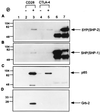Interaction of CTLA-4 with AP50, a clathrin-coated pit adaptor protein
- PMID: 9256472
- PMCID: PMC23153
- DOI: 10.1073/pnas.94.17.9273
Interaction of CTLA-4 with AP50, a clathrin-coated pit adaptor protein
Abstract
CTLA-4 plays a critical role in regulating the immune response. It is mainly located in cytoplasmic vesicles and is expressed only transiently on the surface after T cell activation. In this study, we demonstrate that CTLA-4 is associated with AP50, the medium chain of the clathrin-associated coated pit adaptor protein complex AP2. In a yeast two-hybrid screen, three individual cDNA clones that encode mouse AP50 were isolated, all of which can interact specifically with the cytoplasmic domain of mouse CTLA-4, but not with the cytoplasmic domain of mouse CD28. We have shown that CTLA-4 can bind specifically to AP50 when CTLA-4 and AP50 are cotransfected into human 293T cells. A Y201 to F201 mutation in the YVKM intracellular localization motif of the CTLA-4 cytoplasmic domain significantly diminished its binding to AP50. We also found that AP50 bound to a CTLA-4 peptide containing unphosphorylated Y201 but not to a peptide containing phosphorylated Y201. Conversely, the p85 subunit of phosphatidylinositol 3-kinase and, to a lesser extent, protein tyrosine phosphatase SYP (SHP-2) and SHP (SHP-1) bind only to the CTLA-4 peptide containing phosphorylated Y201. Therefore, the phosphorylation status of Y201 in the CTLA-4 cytoplasmic domain determines the binding specificity of CTLA-4. These results suggest that AP50 and the coated pit adaptor complex AP2 may play an important role in regulating the intracellular trafficking and function of CTLA-4.
Figures






Similar articles
-
Interaction of CTLA-4 with the clathrin-associated protein AP50 results in ligand-independent endocytosis that limits cell surface expression.J Immunol. 1997 Jul 1;159(1):144-51. J Immunol. 1997. PMID: 9200449
-
Study of the interaction of the medium chain mu 2 subunit of the clathrin-associated adapter protein complex 2 with cytotoxic T-lymphocyte antigen 4 and CD28.Biochem J. 2001 Oct 15;359(Pt 2):427-34. doi: 10.1042/0264-6021:3590427. Biochem J. 2001. PMID: 11583591 Free PMC article.
-
Interaction of the cytoplasmic tail of CTLA-4 (CD152) with a clathrin-associated protein is negatively regulated by tyrosine phosphorylation.Biochemistry. 1997 Dec 16;36(50):15975-82. doi: 10.1021/bi971762i. Biochemistry. 1997. PMID: 9398332
-
Tyrosine phosphorylation controls internalization of CTLA-4 by regulating its interaction with clathrin-associated adaptor complex AP-2.Immunity. 1997 May;6(5):583-9. doi: 10.1016/s1074-7613(00)80346-5. Immunity. 1997. PMID: 9175836
-
The 50 kDa protein subunit of assembly polypeptide (AP) AP-2 adaptor from clathrin-coated vesicles is phosphorylated on threonine-156 by AP-1 and a soluble AP50 kinase which co-purifies with the assembly polypeptides.Biochem J. 1993 Dec 1;296 ( Pt 2)(Pt 2):409-15. doi: 10.1042/bj2960409. Biochem J. 1993. PMID: 8257432 Free PMC article.
Cited by
-
CD28, CTLA-4 and their ligands: who does what and to whom?Immunology. 2000 Oct;101(2):169-77. doi: 10.1046/j.1365-2567.2000.00121.x. Immunology. 2000. PMID: 11012769 Free PMC article. Review. No abstract available.
-
Transcriptional profiling of gene expression changes in a PACE-transfected CHO DUKX cell line secreting high levels of rhBMP-2.Mol Biotechnol. 2008 Jul;39(3):187-99. doi: 10.1007/s12033-008-9039-6. Epub 2008 Feb 1. Mol Biotechnol. 2008. PMID: 18240028
-
Tyrosine 201 of the cytoplasmic tail of CTLA-4 critically affects T regulatory cell suppressive function.Eur J Immunol. 2014 Jun;44(6):1737-46. doi: 10.1002/eji.201343891. Epub 2014 Apr 15. Eur J Immunol. 2014. PMID: 24648182 Free PMC article.
-
Conservation and diversification of dileucine signal recognition by adaptor protein (AP) complex variants.J Biol Chem. 2011 Jan 21;286(3):2022-30. doi: 10.1074/jbc.M110.197178. Epub 2010 Nov 19. J Biol Chem. 2011. PMID: 21097499 Free PMC article.
-
Structure-Function analysis of the CTLA-4 interaction with PP2A.BMC Immunol. 2009 Apr 30;10:23. doi: 10.1186/1471-2172-10-23. BMC Immunol. 2009. PMID: 19405949 Free PMC article.
References
-
- Linsley P S, Ledbetter J A. Annu Rev Immunol. 1993;11:191–212. - PubMed
-
- June C H, Bluestone J A, Nadler L M, Thompson C B. Immunol Today. 1994;15:321–331. - PubMed
-
- Allison J P. Curr Opin Immunol. 1994;6:414–419. - PubMed
-
- Brunet J F, Denizot F, Luciani M F, Roux-Dosseto M, Suzan M, Mattei M F, Golstein P. Nature (London) 1987;328:267–270. - PubMed
-
- Harper K, Balzano C, Rouvier E, Mattei M G, Luciani M F, Golstein P. J Immunol. 1991;147:1037–1044. - PubMed
Publication types
MeSH terms
Substances
Grants and funding
LinkOut - more resources
Full Text Sources
Other Literature Sources
Molecular Biology Databases
Research Materials

